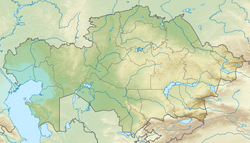| Eginsai Formation | |
|---|---|
| Stratigraphic range: Late Campanian-early Maastrichtian ~ | |
| Type | Geological formation |
| Lithology | |
| Primary | Siltstone |
| Other | Phosphorite |
| Location | |
| Coordinates | 52°24′N64°36′E / 52.4°N 64.6°E |
| Approximate paleocoordinates | 45°30′N56°06′E / 45.5°N 56.1°E |
| Region | Kustanai |
| Country | Kazakhstan |
The Eginsai Formation (Russian: Eginsai Svita) is a geological formation in Kazakhstan whose strata date back to the Late Cretaceous. Dinosaur remains are among the fossils that have been recovered from the formation. [1]
